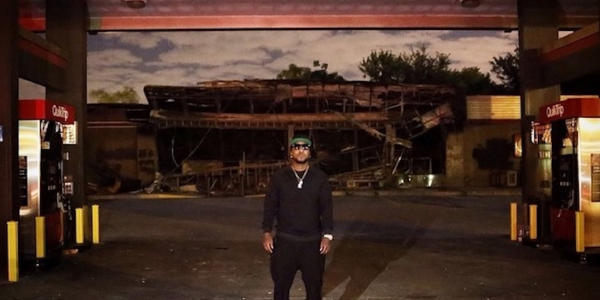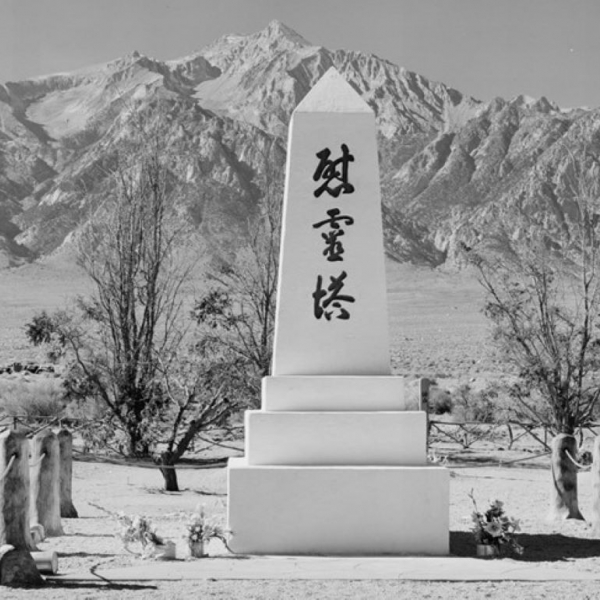As narratives around the demonstrations in Ferguson are reconstituted in light of unfolding events, certain images still and moving have attained fixity. Reconstructions of the story of Michael Brown's death and the aftermath tell new stories with the same images. The images become documents that serve divergent codification of the events.
One of the images that has increased in its role in storytelling is Mya Aaten-White's harrowing selfie showing herself in a neck brace and head bandage in the back of an ambulance. On August 12, minutes before taking the photograph, a bullet likely fired by a police officer struck Aaten-White's head as she walked near the QuikTrip. The bullet caused wounds that turned out to be superficial, but the raw trauma is apparent in the photograph.
As Aaten-White seeks her own justice, her photograph has accompanied stories in outlets from Daily Kos to the St. Louis Post-Dispatch. Aaten-White posted the image on her Instagram without caption, as a direct and factual document that alerted family and friends to her injury. This selfie, in which the subject is presenting actual lived trauma, rather than a statement or stance toward it, makes it the most traumatic circulated image from Ferguson (so far; images of the death of Michael Brown or its immediate after moments could be become public after the grand jury concludes). Roland Barthes writes that "the traumatic photograph... is the photograph about which there is nothing to say." The captionless selfie -- posted because its subject had no idea if she would be conscious for much longer, and no idea who really was responsible for her injury - is an unmotivated representation. Almost all other imagery from Ferguson, even amid police pushback upon demonstrators, carried both motivation and coding in the form of captions or framing.
For example, several celebrities turned up on West Florissant Road, including rapper Young Jeezy who posted on Instagram an image of himself standing in front of the burned-out QuikTrip. In the photograph, Young Jeezy stands perfectly centered between two rows of gas pumps, with the canopy over the pump island lifting upward and out of view. The image encodes a heroic posture, unlike Mya Aaten-White's selfie showing her wounded state, and conveys the subject's ownership of the site and identification with the struggle. The photograph of Young Jeezy transformed him into both visitor and spokesman, and responses from Ferguson confirmed its significance.
Comments on Jeezy's photo from Ferguson residents thanked him for elevating the call for justice, while Jeezy stated that he had to see the place for himself. Yet Jeezy did not post an image in which the QuikTrip itself was a subject, and only posted a photograph of Michael Brown after posting his own portrait. His presence in Ferguson seemed primarily to signify his own identity, and was ultimately dismissed by some critics as self-promotion. On the other hand, Wiz Khalifa joined Young Jeezy on the trip, but never became a visual hero.
Many people of less renown than Young Jeezy created captured imagery from demonstrations, the QuikTrip or Ferguson in general. In much of this imagery, the subject was the poser -- in poses taken by friends, in poses with others on the scene, or in the much-derided "selfie." Recently a young woman's selfie at the Auschwitz concentration camp garnered her infamy through the iterative presentation of the images devoid of her initial social media explanation. Writers and other social media commentators -- many of whom, unlike the woman, never had visited Auschwitz and thus presented no superior mode of documentary presence -- derided a personal image because of its supposed (and strongly disavowed) coding of wanton disrespect.
While the Auschwitz selfie may not constitute a consciously egotistic representation of place, it reflects a trend toward "riot tourism" or "disaster tourism" in which locals, celebrities, politicians and journalists seek to document sites from New Orleans after Katrina to Detroit after decades of depopulation and built environment degradation. In the absence of agency, in which individuals actually dwell in or shape the relief of trauma, the genre of representative presence in photography and video perpetuates a projection of enacted social responsibility. The accumulation of images serves as substitute for mass action for viewers. Thus, the broadcast reception could substitute real participation in humanitarian relief or the collective exercise of democratic power.
Ferguson's parade of Facebook solidarity statements originated largely from those who actually visited the demonstrations, drawing a stronger tie between representation and action. Images from a photographer's point of view staring at a propelled tear gas canister are more informative than aggrandizing. Still, the litany of selfies in front of the QuikTrip, or in locations removed from Ferguson, inspired or reinforced an avoidance of participation. That many people responded to imagery of Ferguson's tribulations without visiting enacted the region's problematic spatial segregation. St. Louisans whose psychological geography of the region already marginalized North County could further marginalize it while objectifying it, without ever setting foot on its sidewalks or streets.
Since the messages are sent on self-controlled channels with self-selected audiences (how many people "blocked" Facebook friends of different views on Mike Brown's death and Darren Wilson's guilt under the law?), social media allows one to avoid discursive multivalence. It compels some people to willfully make their bodies into what Michel Foucault termed "objects of knowledge" -- symbolic, rather than potent, political vessels.
The army of social media auteurs further reduced consumption of Ferguson to a series of individual statements, mostly beheld by those already in agreement with the subject (or virulently in disagreement, manifesting instant and nearly-scripted polarity). Bumper stickers and T-shirts haven descended in semiotic value as platforms for rote espousal of political stances; now the digital representation of the body itself is a far more common -- and even less invested -- messaging. The most repetitious of social media documentation of participant/broadcaster solidarity could be summarized in a pointed line from "Sick 2 Think" by the band Why?: "Who's going to shoot me looking serious / if I don't shoot myself looking serious?"
Yet Ferguson imagery also captured the defusing of traditional political field presence. Civil rights leaders Rev. Al Sharpton and Rev. Jesse Jackson, Sr. met public indifference, despite their conventional role in amplifying local struggles to national audiences. Jackson's appearances at the Ferguson Farmers' Market and the QuikTrip found him seeming tired and disconnected from local resistance leadership. At a church event, Jackson was heckled by a crowd after intervening during fundraising for Michael Brown. Jackson's national voice alleged that "There's a 'Ferguson' near you," the title of his USA Today op-ed, but when he visited the actual ground zero, no one needed the reminder.
On YouTube, Jackson's most famous moment is an instantaneous reversal of his past gravity. Sitting in his car outside of the McDonald's where police had arrested journalists, Jackson receives the hostility of a man with his cell phone camera set recording video. "We don't want you here in St. Louis!" bellows the man, whose simultaneous stances as participant, observer, documenter and "man on the street" defy most previous ways in which media creators had encoded Jesse Jackson in civil rights struggle narratives. In this video, Jackson is neither Young Jeezy's defiant hero, whose brash appropriation of community anguish was clear enough to be transparent, nor Mya Aten-White's injured participant, whose depiction openly expresses her damaged self. Instead, Jackson seems disconnected and abashed -- a figure without relevant presence.
Photography, too, vividly captured political absence at QuikTrip, Canfield and other places. Although Congressman William "Lacy" Clay eventually visited Ferguson, in the imagistic retelling of events, he is not present. Photographs or videos of Clay, if they exist, never made it to the social media transmission systems of Facebook, Instagram, Vine or elsewhere. The probity of Clay's presence in the events in the field supports accusations from demonstrators that the congressman took no real official action in the course of events.
In contrast, the presence of St. Louis Alderman Antonio French, State Senator Maria-Chappelle Nadal, Anthony Shahid and other public figures became so ingrained through image-presence that capturing them on Instagram became confirmation of the reality of one's own position. Well-known and well-documented figures became repeated and reconfirmed signifiers of the reality of Ferguson, mirrored by the absence of Clay, County Executive Charlie Dooley (after the first night of protests, when he was the first elected official to meet crowds) and others.
sources
Barthes, Roland. Image-Music-Text. New York: Hill and Wang, 1977.
"Ferguson Protestor to Rev. Jesse Jackson: "We Don't Want You Here, Brother"
Jackson Sr., Jessie L. "There's a "Ferguson" Near You"
Photo Credit: Photo screenshot from @youngjeezy Instagram account Young Jeezy stands at the Ferguson QuikTrip on August 12, 2014. Source: @younggjeezy Instagram account.





